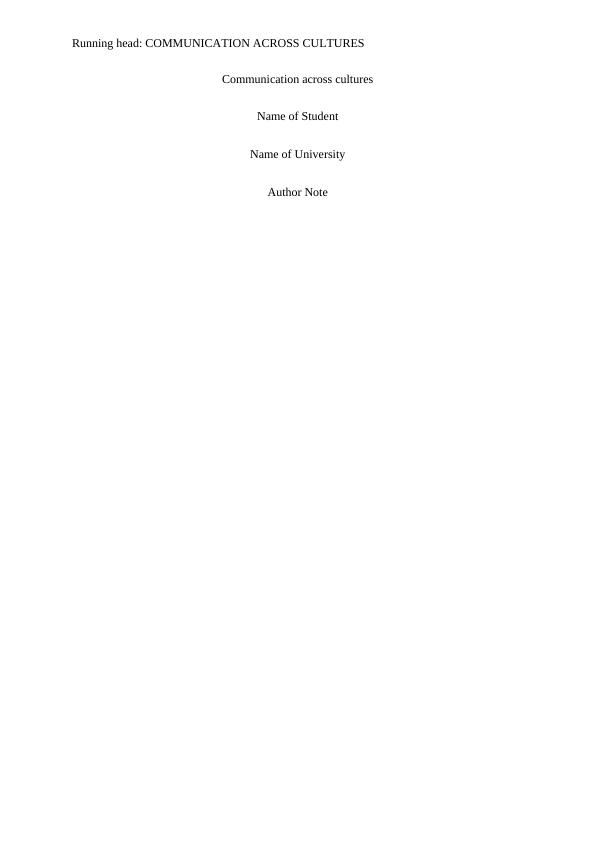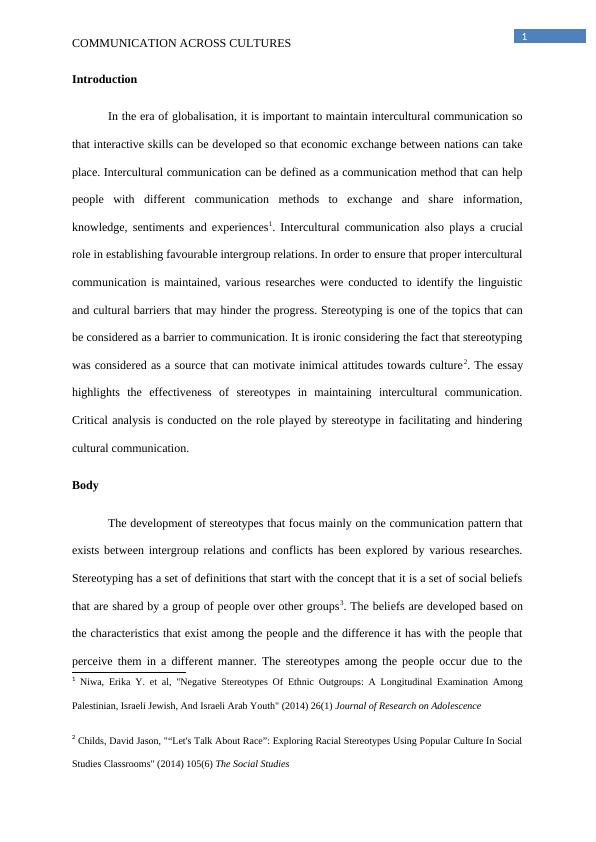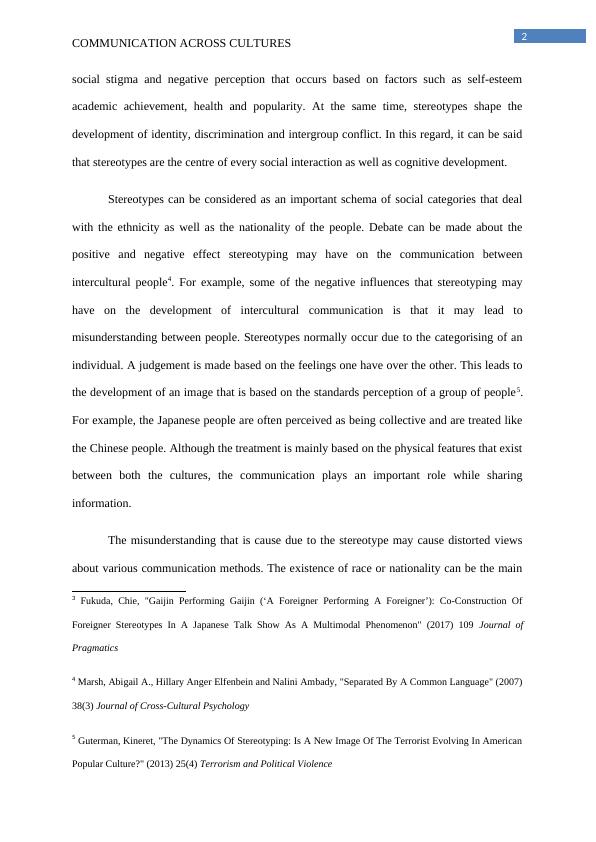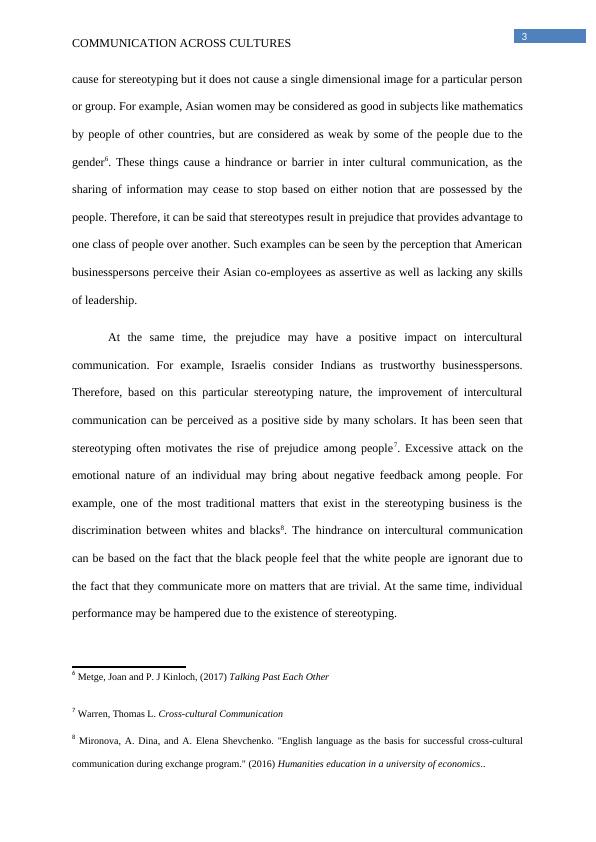Communication Across Cultures: The Role of Stereotypes in Intercultural Communication
Added on 2023-06-11
11 Pages3224 Words321 Views
Running head: COMMUNICATION ACROSS CULTURES
Communication across cultures
Name of Student
Name of University
Author Note
Communication across cultures
Name of Student
Name of University
Author Note

1
COMMUNICATION ACROSS CULTURES
Introduction
In the era of globalisation, it is important to maintain intercultural communication so
that interactive skills can be developed so that economic exchange between nations can take
place. Intercultural communication can be defined as a communication method that can help
people with different communication methods to exchange and share information,
knowledge, sentiments and experiences1. Intercultural communication also plays a crucial
role in establishing favourable intergroup relations. In order to ensure that proper intercultural
communication is maintained, various researches were conducted to identify the linguistic
and cultural barriers that may hinder the progress. Stereotyping is one of the topics that can
be considered as a barrier to communication. It is ironic considering the fact that stereotyping
was considered as a source that can motivate inimical attitudes towards culture2. The essay
highlights the effectiveness of stereotypes in maintaining intercultural communication.
Critical analysis is conducted on the role played by stereotype in facilitating and hindering
cultural communication.
Body
The development of stereotypes that focus mainly on the communication pattern that
exists between intergroup relations and conflicts has been explored by various researches.
Stereotyping has a set of definitions that start with the concept that it is a set of social beliefs
that are shared by a group of people over other groups3. The beliefs are developed based on
the characteristics that exist among the people and the difference it has with the people that
perceive them in a different manner. The stereotypes among the people occur due to the
1 Niwa, Erika Y. et al, "Negative Stereotypes Of Ethnic Outgroups: A Longitudinal Examination Among
Palestinian, Israeli Jewish, And Israeli Arab Youth" (2014) 26(1) Journal of Research on Adolescence
2 Childs, David Jason, "“Let's Talk About Race”: Exploring Racial Stereotypes Using Popular Culture In Social
Studies Classrooms" (2014) 105(6) The Social Studies
COMMUNICATION ACROSS CULTURES
Introduction
In the era of globalisation, it is important to maintain intercultural communication so
that interactive skills can be developed so that economic exchange between nations can take
place. Intercultural communication can be defined as a communication method that can help
people with different communication methods to exchange and share information,
knowledge, sentiments and experiences1. Intercultural communication also plays a crucial
role in establishing favourable intergroup relations. In order to ensure that proper intercultural
communication is maintained, various researches were conducted to identify the linguistic
and cultural barriers that may hinder the progress. Stereotyping is one of the topics that can
be considered as a barrier to communication. It is ironic considering the fact that stereotyping
was considered as a source that can motivate inimical attitudes towards culture2. The essay
highlights the effectiveness of stereotypes in maintaining intercultural communication.
Critical analysis is conducted on the role played by stereotype in facilitating and hindering
cultural communication.
Body
The development of stereotypes that focus mainly on the communication pattern that
exists between intergroup relations and conflicts has been explored by various researches.
Stereotyping has a set of definitions that start with the concept that it is a set of social beliefs
that are shared by a group of people over other groups3. The beliefs are developed based on
the characteristics that exist among the people and the difference it has with the people that
perceive them in a different manner. The stereotypes among the people occur due to the
1 Niwa, Erika Y. et al, "Negative Stereotypes Of Ethnic Outgroups: A Longitudinal Examination Among
Palestinian, Israeli Jewish, And Israeli Arab Youth" (2014) 26(1) Journal of Research on Adolescence
2 Childs, David Jason, "“Let's Talk About Race”: Exploring Racial Stereotypes Using Popular Culture In Social
Studies Classrooms" (2014) 105(6) The Social Studies

2
COMMUNICATION ACROSS CULTURES
social stigma and negative perception that occurs based on factors such as self-esteem
academic achievement, health and popularity. At the same time, stereotypes shape the
development of identity, discrimination and intergroup conflict. In this regard, it can be said
that stereotypes are the centre of every social interaction as well as cognitive development.
Stereotypes can be considered as an important schema of social categories that deal
with the ethnicity as well as the nationality of the people. Debate can be made about the
positive and negative effect stereotyping may have on the communication between
intercultural people4. For example, some of the negative influences that stereotyping may
have on the development of intercultural communication is that it may lead to
misunderstanding between people. Stereotypes normally occur due to the categorising of an
individual. A judgement is made based on the feelings one have over the other. This leads to
the development of an image that is based on the standards perception of a group of people5.
For example, the Japanese people are often perceived as being collective and are treated like
the Chinese people. Although the treatment is mainly based on the physical features that exist
between both the cultures, the communication plays an important role while sharing
information.
The misunderstanding that is cause due to the stereotype may cause distorted views
about various communication methods. The existence of race or nationality can be the main
3 Fukuda, Chie, "Gaijin Performing Gaijin (‘A Foreigner Performing A Foreigner’): Co-Construction Of
Foreigner Stereotypes In A Japanese Talk Show As A Multimodal Phenomenon" (2017) 109 Journal of
Pragmatics
4 Marsh, Abigail A., Hillary Anger Elfenbein and Nalini Ambady, "Separated By A Common Language" (2007)
38(3) Journal of Cross-Cultural Psychology
5 Guterman, Kineret, "The Dynamics Of Stereotyping: Is A New Image Of The Terrorist Evolving In American
Popular Culture?" (2013) 25(4) Terrorism and Political Violence
COMMUNICATION ACROSS CULTURES
social stigma and negative perception that occurs based on factors such as self-esteem
academic achievement, health and popularity. At the same time, stereotypes shape the
development of identity, discrimination and intergroup conflict. In this regard, it can be said
that stereotypes are the centre of every social interaction as well as cognitive development.
Stereotypes can be considered as an important schema of social categories that deal
with the ethnicity as well as the nationality of the people. Debate can be made about the
positive and negative effect stereotyping may have on the communication between
intercultural people4. For example, some of the negative influences that stereotyping may
have on the development of intercultural communication is that it may lead to
misunderstanding between people. Stereotypes normally occur due to the categorising of an
individual. A judgement is made based on the feelings one have over the other. This leads to
the development of an image that is based on the standards perception of a group of people5.
For example, the Japanese people are often perceived as being collective and are treated like
the Chinese people. Although the treatment is mainly based on the physical features that exist
between both the cultures, the communication plays an important role while sharing
information.
The misunderstanding that is cause due to the stereotype may cause distorted views
about various communication methods. The existence of race or nationality can be the main
3 Fukuda, Chie, "Gaijin Performing Gaijin (‘A Foreigner Performing A Foreigner’): Co-Construction Of
Foreigner Stereotypes In A Japanese Talk Show As A Multimodal Phenomenon" (2017) 109 Journal of
Pragmatics
4 Marsh, Abigail A., Hillary Anger Elfenbein and Nalini Ambady, "Separated By A Common Language" (2007)
38(3) Journal of Cross-Cultural Psychology
5 Guterman, Kineret, "The Dynamics Of Stereotyping: Is A New Image Of The Terrorist Evolving In American
Popular Culture?" (2013) 25(4) Terrorism and Political Violence

3
COMMUNICATION ACROSS CULTURES
cause for stereotyping but it does not cause a single dimensional image for a particular person
or group. For example, Asian women may be considered as good in subjects like mathematics
by people of other countries, but are considered as weak by some of the people due to the
gender6. These things cause a hindrance or barrier in inter cultural communication, as the
sharing of information may cease to stop based on either notion that are possessed by the
people. Therefore, it can be said that stereotypes result in prejudice that provides advantage to
one class of people over another. Such examples can be seen by the perception that American
businesspersons perceive their Asian co-employees as assertive as well as lacking any skills
of leadership.
At the same time, the prejudice may have a positive impact on intercultural
communication. For example, Israelis consider Indians as trustworthy businesspersons.
Therefore, based on this particular stereotyping nature, the improvement of intercultural
communication can be perceived as a positive side by many scholars. It has been seen that
stereotyping often motivates the rise of prejudice among people7. Excessive attack on the
emotional nature of an individual may bring about negative feedback among people. For
example, one of the most traditional matters that exist in the stereotyping business is the
discrimination between whites and blacks8. The hindrance on intercultural communication
can be based on the fact that the black people feel that the white people are ignorant due to
the fact that they communicate more on matters that are trivial. At the same time, individual
performance may be hampered due to the existence of stereotyping.
6 Metge, Joan and P. J Kinloch, (2017) Talking Past Each Other
7 Warren, Thomas L. Cross-cultural Communication
8 Mironova, A. Dina, and A. Elena Shevchenko. "English language as the basis for successful cross-cultural
communication during exchange program." (2016) Humanities education in a university of economics..
COMMUNICATION ACROSS CULTURES
cause for stereotyping but it does not cause a single dimensional image for a particular person
or group. For example, Asian women may be considered as good in subjects like mathematics
by people of other countries, but are considered as weak by some of the people due to the
gender6. These things cause a hindrance or barrier in inter cultural communication, as the
sharing of information may cease to stop based on either notion that are possessed by the
people. Therefore, it can be said that stereotypes result in prejudice that provides advantage to
one class of people over another. Such examples can be seen by the perception that American
businesspersons perceive their Asian co-employees as assertive as well as lacking any skills
of leadership.
At the same time, the prejudice may have a positive impact on intercultural
communication. For example, Israelis consider Indians as trustworthy businesspersons.
Therefore, based on this particular stereotyping nature, the improvement of intercultural
communication can be perceived as a positive side by many scholars. It has been seen that
stereotyping often motivates the rise of prejudice among people7. Excessive attack on the
emotional nature of an individual may bring about negative feedback among people. For
example, one of the most traditional matters that exist in the stereotyping business is the
discrimination between whites and blacks8. The hindrance on intercultural communication
can be based on the fact that the black people feel that the white people are ignorant due to
the fact that they communicate more on matters that are trivial. At the same time, individual
performance may be hampered due to the existence of stereotyping.
6 Metge, Joan and P. J Kinloch, (2017) Talking Past Each Other
7 Warren, Thomas L. Cross-cultural Communication
8 Mironova, A. Dina, and A. Elena Shevchenko. "English language as the basis for successful cross-cultural
communication during exchange program." (2016) Humanities education in a university of economics..

End of preview
Want to access all the pages? Upload your documents or become a member.
Related Documents
Barriers to Intercultural Communication: Language and Cultural Differenceslg...
|6
|1228
|346
Stereotypes in Transcultural Communication at Worklg...
|5
|934
|327
Inter-group Conflicts Paper Assignment - Deskliblg...
|7
|1479
|330
Problems of Ethnocentric Viewpoint in Intercultural Communicationlg...
|5
|1363
|460
CULTURAL AND INTERCULTURAL COMMUNICATIONlg...
|7
|1428
|22
Different levels of culture and barriers to intercultural communicationlg...
|6
|1513
|94
